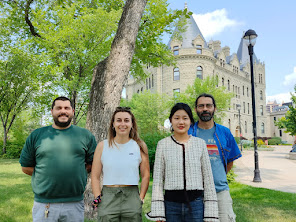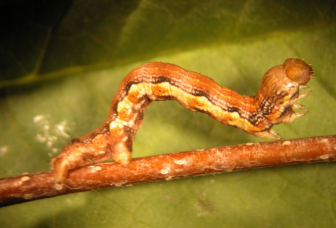Picture of all the team members
🌻 Eloise 🌻
🎤 Hi! So, tell us about you! What's your name? Where are you from?
Hi! I'm Eloise, I'm 24 and I'm from France.
🎤 What do you do in France?
I'm an engineering student, I study mathematics, physic, mechanic and many other things! In France, I'm an apprentice at a company : I do both courses and work in that company. It's a lot of work but it's really cool to learn the different skills needed for various positions.
🎤 So, why did you choose to do your 4th year's internship in biology?
Well, biology is a domain that always interest me. Before going in an engineering school, I did a year in a medicine school, but I finally stopped because there was no mutual aid and no teamwork... Doing my internship in biology was a good opportunity for me to learn more about it.
🎤 How's life in Canada?
Really good! I met a lot of people here, all of them very nice! I was a little bit worried about people in Canada because I was told that they're not really kind with strangers and that I'll have to be careful with what I say, but so far, every person I have met has been really helpful and kind with me.
🎤 Do you like Canada?
I really like Canada, there are a lot of beautiful places to discover, so many different cultures and a lot of diversity. The only thing I regret is not having enough time to explore all.
🎤 Do you find your internship interesting?
Yeah, my internship is really interesting, I learned a lot about the city, the trees and the cankerworms since I arrived. My professor is really patient and kind, he really helps me to improve my English!
🎤 Thanks Eloïse for your time, we'll see you soon!
🍪 Jiaxin 🍪
🎤 Hi, everybody! Let me introduce myself to you first!
My name is Zhang Jiaxin. Zhang is my last name and Jiaxin is my first name. So you can call me Jiaxin. I am a 21-year-old Chinese girl. And I come here this summer for a three-months internship, taking part in the science project and being a member of Dr. Á vila'slab.
🎤 What do you do in China?
In China, I major in horticulture, the study of fruit trees, vegetables, flowers and tea. I still have one more year of studies at my university before I can graduate. After my graduation, I plan to further my studies on plants by joining a graduate program.
🎤 So what do you think about this internship?
I was very excited to get the chance to come here for the project. I am interested in studying how the animals affect the trees, and I think it's very cool to come to another country and meet new friends from all over the world.
🎤 How's life in Canada?
Actually, I really love the weather here in summer. I have heard winter it's terrible here, but I really want to see the snow scene. People I meet here so far are really nice so I enjoy these days very much! Lastly, I hope our results do help improve the environment here!














